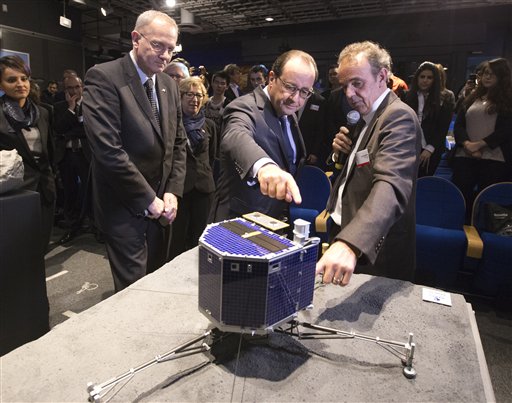Comet lander Philae awakes from hibernation

In this Nov. 12, 2014, file photo, French President Francois Hollande, center, with French astrophysicist Francis Rocard looks at a model of Rosetta lander Philae, as they visit the Cite des Sciences at La Villette in Paris during a broadcast of the Rosetta mission as it orbits around comet 67/P Churyumov-Gersimenko. The European Space Agency says its comet lander Philae has woken up from hibernation. AP PHOTO/JACQUES BRINON
BERLIN—The comet lander Philae has awoken from a seven-month hibernation and managed to communicate with Earth for more than a minute, the European Space Agency said Sunday.
The probe became the first spacecraft to land on a comet when it touched down on the icy surface of 67P/Churyumov-Gerasimenko in November. After its historic landing, Philae managed to conduct experiments and send data to Earth for about 60 hours before its batteries were depleted and it was forced to shut down its systems.
Scientists hoped the probe would wake up again as the comet approached the sun, when its solar panels would soak up enough light to charge the on-board battery.
Those hopes were confirmed at 10:28 p.m. (2028 GMT; 4:28 p.m. EDT) on Saturday, when the lander sent a signal back to Earth.
“I’m not really surprised it happened, but if you wait for several months and then suddenly in the middle of the night you get a call saying ‘we have a signal from Philae,’ it’s exciting,” said Stephan Ulamec, project manager at the German Aerospace Center, or DLR. “We’re very happy.”
The brief burst of communication contained 300 packages of data that were relayed by the probe’s mother ship Rosetta, which is orbiting the comet.
“We only received data for about 85 seconds. These data are housekeeping and system data from the lander,” said Ulamec. It was enough to tell scientists that the probe is doing well and getting sufficient sunlight to keep communicating.
Ulamec said the probe appears to have been awake for several days before it called home, because some of the packages scientists received contained historical data.
They will now work to change Rosetta’s orbit so that the link to the lander lasts for longer and they can start sending commands for it to carry out new measurements, resulting in fresh scientific data. The next opportunity to communicate with Philae should come on Sunday night, said Ulamec.
Scientists also hope that Philae’s restart will allow them to pinpoint where the probe landed. Its exact location has been a mystery, though scientists have narrowed down the likely landing site based on images and other measurements received from Philae and Rosetta.
Comet 67P is currently near the orbit of Mars. On Aug. 13 it will reach the point at which it is closest to the sun—known as perihelion — before swinging back out again. Ulamec said the lander should get enough sunlight to operate until October, when it will once again fall silent, possibly forever.–Frank Jordans